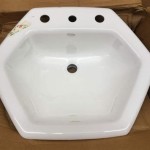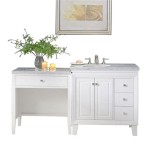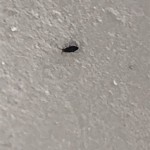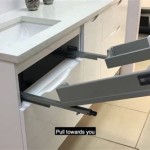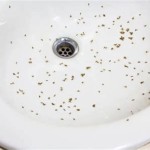Dripping Pipe Under Bathroom Sink: Identification, Causes, and Solutions
A dripping pipe under the bathroom sink is a common household plumbing issue that can range from a minor annoyance to a significant source of water waste and potential property damage. This article will provide a comprehensive overview of identifying a leak, understanding the most common causes, and outlining effective solutions, empowering homeowners to address this problem efficiently and prevent further complications.
Identifying the Source of the Drip
The initial step in addressing a dripping pipe is accurately identifying the source of the leak. This requires a careful examination of the plumbing components beneath the sink, including the drainpipe assembly, supply lines, and shut-off valves. Often, the origin of the drip is not immediately obvious, as water can travel along the surface of pipes before accumulating and dripping from a seemingly unrelated point.
Begin by drying all the pipes and connections thoroughly with a clean cloth or paper towels. This eliminates existing moisture and makes it easier to observe where the water is actively emerging. After drying, slowly run the water in the sink, both hot and cold, and observe the pipes for any signs of leakage. Check each connection point meticulously, paying close attention to areas where pipes join together, such as threaded connections, compression fittings, and slip nuts.
If the leak only occurs when the drain is in use, the problem is likely within the drainpipe assembly. This includes the tailpiece (the pipe directly beneath the sink drain), the P-trap (the curved pipe that traps debris and prevents sewer gases from entering the bathroom), and the drainpipe that connects to the wall. Examine these components for cracks, loose connections, or deteriorated seals.
If the leak occurs regardless of drain use, the issue may stem from the supply lines that deliver hot and cold water to the faucet. These lines are typically made of flexible copper, braided stainless steel, or PEX tubing. Check the connections at the shut-off valves (located beneath the sink) and at the faucet tailpieces for any signs of leakage. Also, inspect the supply lines themselves for punctures, kinks, or signs of corrosion. The shut-off valves themselves can also be a source of leaks. Examine the valve stem and handle for drips, indicating a worn-out packing nut or O-ring.
In cases where the drip is intermittent or difficult to pinpoint, a flashlight and a small mirror can be helpful tools for inspecting hard-to-reach areas. Running the water for an extended period, or filling the sink and then draining it, can sometimes help to reveal more subtle leaks.
Common Causes of Dripping Pipes Under the Bathroom Sink
Once the source of the drip has been identified, understanding the underlying cause is crucial for selecting the appropriate repair method. Several factors can contribute to leaks in the under-sink plumbing, ranging from simple loose connections to more complex issues like corrosion or damaged components.
Loose Connections: One of the most frequent causes of dripping pipes is simply loose connections. Over time, vibrations from water flowing through the pipes, temperature fluctuations, and general usage can cause fittings to loosen. This is particularly common with compression fittings and slip nuts, which rely on friction to create a watertight seal. A slight tightening of these fittings can often resolve the issue. However, avoid overtightening, as this can damage the fitting or the pipe itself.
Worn-Out Washers and O-Rings: Washers and O-rings are used to create watertight seals in various plumbing connections, including faucet connections, valve stems, and drainpipe assemblies. These components are typically made of rubber or plastic, and they can degrade over time due to exposure to water, chemicals, and temperature variations. When washers and O-rings become brittle, cracked, or flattened, they lose their ability to form a proper seal, leading to leaks. Replacement of these worn-out components is usually a straightforward and inexpensive repair.
Corrosion: Corrosion can weaken pipes and fittings, eventually leading to leaks. This is more common in older homes with galvanized steel pipes, which are susceptible to rust. However, even copper pipes can corrode under certain conditions, such as exposure to acidic water or improper grounding. Corrosion typically manifests as rust-colored stains, pitting, or flaking on the surface of the pipe. In severe cases, the pipe may develop holes or cracks. Depending on the extent of the corrosion, the affected section of pipe may need to be replaced.
Clogged Drain: A clogged drain can create back pressure in the drainpipe assembly, forcing water to leak from weak points or loose connections. Hair, soap scum, and other debris can accumulate in the P-trap and drainpipe, restricting water flow. Addressing the clog can relieve the pressure and stop the leak. Using a plunger or drain snake can often clear minor clogs. For more stubborn blockages, chemical drain cleaners may be used, but these should be handled with caution as they can damage pipes and pose health risks.
Damaged or Cracked Pipes: Physical damage to pipes, such as cracks or punctures, can result from accidental impact, freezing temperatures, or aging. Even small cracks can cause significant leaks over time. Damaged pipes typically require replacement of the affected section. In some cases, a temporary patch, such as a pipe clamp or epoxy putty, can be used to stop the leak until a permanent repair can be made.
High Water Pressure: Excessively high water pressure can put stress on plumbing systems, leading to leaks at joints and fittings. A pressure regulator is typically installed where the main water line enters the house to maintain a safe and consistent water pressure. If the pressure regulator malfunctions or is not properly adjusted, the water pressure may become too high. A plumber can test the water pressure and adjust or replace the pressure regulator if necessary.
Solutions for a Dripping Pipe
The solution for a dripping pipe under the bathroom sink depends on the identified cause. Addressing the problem promptly can prevent further water damage, mold growth, and higher water bills. For minor issues, a homeowner with basic plumbing skills can often perform the repair. However, for more complex problems, it is advisable to consult a qualified plumber.
Tightening Loose Connections: For leaks caused by loose connections, the first step is to gently tighten the affected fitting. Use a wrench to tighten compression fittings and slip nuts, but be careful not to overtighten them, as this can damage the fitting or the pipe. A quarter turn beyond hand-tight is often sufficient. After tightening, dry the area and check for leaks. If the leak persists, the fitting may need to be disassembled and inspected for damage or wear.
Replacing Washers and O-Rings: Replacing worn-out washers and O-rings is a relatively simple task. First, shut off the water supply to the affected area by turning off the shut-off valves under the sink. Disconnect the fitting and remove the old washer or O-ring. Take the old component to a hardware store to ensure that you purchase a properly sized replacement. Install the new washer or O-ring and reassemble the fitting. Turn the water supply back on and check for leaks.
Repairing or Replacing Corroded Pipes: The repair or replacement of corroded pipes depends on the severity of the corrosion. For minor surface corrosion, a wire brush can be used to remove the rust, and then a rust-inhibiting primer and paint can be applied to protect the pipe. However, if the corrosion has significantly weakened the pipe, it should be replaced. This typically involves cutting out the corroded section of pipe and replacing it with a new section of pipe and appropriate fittings. Depending on the type of pipe, this may require soldering, threading, or using compression fittings. If the pipe is severely corroded, it is best to enlist a professional plumber.
Clearing Clogged Drains: Clogged drains can be cleared using a variety of methods. A plunger can be used to create suction and dislodge the clog. A drain snake, also known as a plumber's snake, can be inserted into the drainpipe to break up or retrieve the blockage. Chemical drain cleaners can also be used, but these should be used with caution, following the manufacturer's instructions carefully. Wear gloves and eye protection when using chemical drain cleaners. In some cases, the P-trap may need to be disassembled to remove the clog manually. Place a bucket under the P-trap to catch any water and debris that may spill out.
Patching or Replacing Damaged Pipes: Small cracks or punctures in pipes can sometimes be temporarily patched using a pipe clamp or epoxy putty. A pipe clamp is a metal band that is tightened around the pipe to compress the crack and stop the leak. Epoxy putty is a two-part compound that is mixed together and applied to the crack to create a waterproof seal. These are temporary solutions and the damaged section of pipe should be replaced as soon as possible. Replacing a damaged section of pipe involves cutting out the damaged section and installing a new section of pipe with appropriate fittings. This may require soldering, threading, or using compression fittings, depending on the type of pipe.
Adjusting Water Pressure: If the water pressure is too high, a plumber can adjust or replace the pressure regulator. The pressure regulator is typically located where the main water line enters the house. A plumber can use a pressure gauge to measure the water pressure and adjust the regulator to the appropriate setting. The recommended water pressure for most homes is between 40 and 60 psi (pounds per square inch).
Using Plumber's Tape (Thread Seal Tape): Plumber's tape, also known as Teflon tape or thread seal tape, is a thin, white tape that is used to create a watertight seal on threaded pipe connections. It is wrapped around the threads of the pipe before the fitting is screwed on. The tape fills the gaps between the threads and prevents leaks. When using plumber's tape, wrap it clockwise around the threads, overlapping each layer slightly. Apply several layers of tape for a good seal. Do not use plumber's tape on compression fittings, as these do not rely on threaded connections for a seal.
Using Pipe Joint Compound (Pipe Dope): Pipe joint compound, also known as pipe dope, is a paste-like substance that is used to create a watertight seal on threaded pipe connections. It is applied to the threads of the pipe before the fitting is screwed on. The compound fills the gaps between the threads and prevents leaks. When using pipe joint compound, apply it evenly to the threads, covering all the threads. Do not use pipe joint compound on compression fittings, as these do not rely on threaded connections for a seal.
By meticulously investigating the source of the drip, understanding the contributing factors, and implementing the appropriate solution, homeowners can effectively address a dripping pipe under the bathroom sink and prevent further damage to their property.

Bathroom Sink Drain Leaking Around Threads Premier Plumbing Inc

How To Handle Leaking Pipes Under The Bathroom Sink Aggressive Mechanical

Easy Ways To Fix A Leaky Sink Trap 12 Steps With Pictures

How To Fix Constant Leak Under Bathroom Bunnings Work Community

Trap Leaking Under Bathroom Vanity Doityourself Com Community Forums

Bathroom Sink Drain Leaking Around Threads Premier Plumbing Inc

Hose Under Your Sink Is Leaking Here S What You Have To Do

4 Simple Ways To Fix A Leaky Sink Drain Pipe Wikihow

How To Fix Constant Leak Under Bathroom Bunnings Work Community

How To Tell You Have A Leaking Pipe Under The Bathroom Sink Leak Tracers Direct
Related Posts
